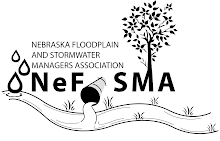Hydrologic Operations:
-Flow and volume attenuation
-Volume reduction
Physical Treatment Operations:
-Particle size alteration
-Physical sorption
-Size separation and exclusion
-Density, gravity, inertial separation
-Aeration and volatilization
-Physical agent disinfection
Biological Processes:
-Microbiotically mediated transforamtion (oxidation, reduction or facultative processes)
-Uptake and storage
Chemical Processes:
-Chemical sorption processes
-Coagulation/flocculation
-Ion exchange
-Chemical disinfection
John Gulliver delivered the Water Resources Seminar topic on Wednesday March 30th, 2011. The topic was "Innovations in Stormwater Treatment". It was nice to see a larger crowd attend this time (estimated 100) to hear about the research being done by the University of Minnesota. At the St. Anthony Falls Laboratory, his research team is looking for ways to use a sand filter (physical treatment operation) that is amended to promote treatment of the dissolved portion of pollutants in urban stormwater flows.
Research available from Dr. Robert Pitt and others shows that up to 45% of the Phosphorous load in urban stormwater runoff is dissolved, meaning it won't settle or filter out. Many of the current BMPs that are designed for the landscape rely heavily on hydrologic and physical treatment operations and would not generally address the dissolved portion, leaving portions of the stormwater discharges untreated. This does not meet the regulatory requirements in the Clean Water Act. Even worse, in recent studies, some of the amended soils and compost layers installed into the Physical Treatment Operations and Biological Processes (constructed wetlands, bioswales, rain gardens) are actually shown to be releasing Phosphorous into the groundwater or underdrains.
_______________________________________________________________
"If a man has good corn or wood, or boards, or pigs, to sell, or can make better chairs or knives, crucibles or church organs, than anybody else, you will find a broad hard-beaten road to his house, though it be in the woods." —Ralph Waldo Emerson
_______________________________________________________________
To provide solutions to these two documented problems, the University of Minnesota team has developed great research supporting the use of an Enhanced Sand Filter to precipitate and/or adsorb the dissolved Phosphorous within the BMP. There are two sand filter types, the Austin and the Delaware, that have been in use for some time now. Precipitation of dissolved pollutants in a sand filter is generally undesirable as it would cause clogging. The "Minnesota Sand Filter" suggests enhancements to that sand filter BMP by adding an adsorption media such as iron filings, calcareous sand, aluminum oxide, steel wool, and steel industry by-products into the sand mixture.
Enhanced Sand Filter example is discussed here for a project in Maplewood, MN
 |
| Sand filter enhanced with iron filings to remove dissolved phosphorous from stormwater (Maplewood, MN). (Courtesy A. Erickson) via link above |
Other possible applications were presented as well and are being researched. During the social hour after the presentation, many innovative ideas of how to incorporate the Minnesota Sand Filter into other BMPs were discussed.
Many audience questions were proposed and discussed, such as:
-How communities would amortize the cost of replacement,
-If public or private installations were most common,
-What is the optimal amended media percentage (5% iron filings),
-Would there be interference from other pollutants,
-Would pretreatment be necessary, and
-Would biological growth in the media be a concern.
Are you interested in these questions? Does anyone in Nebraska want to be the first to experiment with the Minnesota Sand Filter? Leave a comment below about a project that you might consider this application for.
Follow the research team's work http://stormwater.safl.umn.edu/, but I'm sure we will hear much more about the Minnesota Sand Filter in the near term as Nebraska continues evaluating BMPs. Thanks again to the University of Nebraska Stormwater Team for lining up another great speaker. Next up is Bill Hunt, North Carolina State University-Extention April 13th at 3:30 inside Hardin Hall first floor auditorium on UNL East Campus.







